Home Design Tips to Maximize Warmth
Building a house for year-round comfort isn’t always easy. You must consider the home’s overall design, heating systems, and many different features that all contribute to its heat retention and your family’s comfort. While not always an easy process, you can find some helpful home design tips to maximize warmth in your new home below:
Invest in Good Heating Systems
Good heating systems can be integral to a warm and comfortable floor. Start researching heat pumps, furnaces, and electric heated floor systems for low-cost heating in hard-to-heat places. A great deal of research can be required to choose the right heating system for your home. Typically, you must consider:
- The size of your home
- The number of rooms
- Your insulation levels
- Your home’s ceiling height

Install Insulation
Don’t underestimate the value of high-quality insulation in your home when you’re trying to make and retain heat for comfort. Good insulation is integral to heat loss prevention and maintaining a comfortable home temperature.
Choose fiberglass or cellulose insulation and ensure it’s installed in your home’s walls, floors, and roof. You can also reduce heat loss and minimize drafts by sealing around windows, doors, and openings during renovations.
Prioritize Superior Windows
There can be a significant price difference between entry-level windows and windows with double and triple glazing. While you might be on a budget, prioritize those superior and more expensive windows. Double and triple glazing can contribute to a warmer and more comfortable home.
The additional glazing works by trapping air pockets between two or three panes of glass. It’s a great insulator and can prevent condensation and cool air from entering your home. Many people also notice less street noise and energy savings.
Plan Orientation
Building a house from the ground up can be an exciting occasion. You can plan every design element around your unique needs. However, home design can also require a great deal of thought since you have to consider the finer details like orientation. Your home’s orientation can contribute to its warmth and comfort.
Always aim for an orientation that will let your home harness the sun’s energy. This can mean that you’d install plenty of windows on the southern side for optimal sunlight during the day. The large windows can absorb solar heat, resulting in a reduced need for heating and even artificial lighting.
Incorporate Thermal Design Features
Once your new home is built with the correct orientation, glazing, and insulation, you can look at interior features to contribute to its warmth. Thermal design features can be an excellent place to start. Consider thick, lined curtains featuring insulating materials like wool or even velvet. Thick curtains can provide a barrier against cold air while helping to retain heat.
If you won’t be installing curtains in your new home, consider thermal blinds. Depending on where you buy them, they typically have reflective backings to bounce heat into a room. They are also effective in preventing heat loss.
A new home doesn’t mean a warm home. There are several actions you must take to ensure a house is as warm and comfortable as possible. Consider orientation, windows, insulation, and heating systems, and you may be well on your way to enjoying a warm, dry, and comfortable home year-round.






